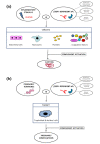Antiphospholipid syndrome in 2014: more clinical manifestations, novel pathogenic players and emerging biomarkers
- PMID: 25166960
- PMCID: PMC4060447
- DOI: 10.1186/ar4549
Antiphospholipid syndrome in 2014: more clinical manifestations, novel pathogenic players and emerging biomarkers
Abstract
The clinical spectrum of the anti-phospholipid syndrome (APS) is not limited to vascular thrombosis or miscarriages but includes additional manifestations that cannot be explained solely by a thrombophilic state. Anti-cardiolipin, anti-beta₂ glycoprotein I (anti-β₂GPI) and lupus anticoagulant (LA) assays are not only the formal diagnostic and classification laboratory tools but also parameters to stratify the risk to develop the clinical manifestations of the syndrome. In particular, anti-β₂GPI antibodies reacting with an immunodominant epitope on domain I of the molecule were reported as the prevalent specificity in APS patients, correlating with a more aggressive clinical picture. Several laboratory assays to improve the diagnostic and predictive power of the standard tests have been proposed. Plates coated with the phosphatidylserine-prothrombin complex for detecting antibodies represent a promising laboratory tool correlating with LA and with clinical manifestations. Anti-phospholipid antibodies can be found in patients with full-blown APS, in those with thrombotic events or obstetric complications only or in asymptomatic carriers. An inflammatory second hit is required to increase the presence of β₂GPI in vascular tissues, eventually triggering thrombosis. Post-transcriptional modifications of circulating β₂GPI, different epitope specificities or diverse anti-β₂GPI antibody-induced cell signaling have all been suggested to affect the clinical manifestations and/or to modulate their occurrence.
Figures

References
-
- Miyakis S, Lockshin MD, Atsumi T, Branch DW, Brey RL, Cervera R, Derksen RH, DE Groot PG, Koike T, Meroni PL, Reber G, Shoenfeld Y, Tincani A, Vlachoyiannopoulos PG, Krilis SA. International consensus statement on an update of the classification criteria for definite antiphospholipid syndrome (APS) J Thromb Haemost. 2006;4:295–306. doi: 10.1111/j.1538-7836.2006.01753.x. - DOI - PubMed
-
- Cervera R, Khamashta MA, Shoenfeld Y, Camps MT, Jacobsen S, Kiss E, Zeher MM, Tincani A, Kontopoulou-Griva I, Galeazzi M, Bellisai F, Meroni PL, Derksen RH, de Groot PG, Gromnica-Ihle E, Baleva M, Mosca M, Bombardieri S, Houssiau F, Gris JC, Quéré I, Hachulla E, Vasconcelos C, Roch B, Fernández-Nebro A, Piette JC, Espinosa G, Bucciarelli S, Pisoni CN, Bertolaccini ML. et al.Euro-Phospholipid Project Group (European Forum on Antiphospholipid Antibodies). Morbidity and mortality in the antiphospholipid syndrome during a 5-year period: a multicentre prospective study of 1000 patients. Ann Rheum Dis. 2009;68:1428–1432. - PubMed
-
- Cervera R, Espinosa G. Update on the catastrophic antiphospholipid syndrome and the 'CAPS Registry'. Semin Thromb Hemost. 2012;38:333–338. - PubMed
Publication types
MeSH terms
Substances
LinkOut - more resources
Full Text Sources
Other Literature Sources
Miscellaneous

